Growing herbs indoors has become increasingly popular, not just among gardening enthusiasts but also for those who want fresh herbs at their fingertips year-round. Indoor herb gardening is ideal for urban dwellers, small-space gardeners, or anyone looking to elevate their culinary dishes with fresh, homegrown ingredients. This comprehensive guide will cover everything you need to know about how to grow herbs indoors successfully, from choosing the best herbs to setting up your garden, and using the right techniques for care and maintenance.
Why You Should Grow Herbs Indoors
Indoor herb gardening offers numerous benefits that go beyond convenience. Here are some of the top reasons why you should consider growing herbs indoors:
1. Fresh Herbs Year-Round
Whether it’s the middle of winter or a hot summer day, growing herbs indoors ensures you have access to fresh, flavorful herbs all year long. You’ll never need to rely on store-bought dried herbs again.
2. Maximize Small Spaces
For those with limited outdoor space, indoor herb gardens are the perfect solution. You can grow herbs on a windowsill, kitchen counter, or even hang them in vertical planters, maximizing every square inch of space.
3. Health and Wellness
Indoor plants, including herbs, can improve air quality by absorbing carbon dioxide and releasing oxygen. Some herbs, like lavender and rosemary, are also known for their calming effects and can reduce stress.
4. Eco-Friendly
Growing your own herbs is a sustainable practice that reduces plastic packaging and transportation emissions. Plus, you control the growing process, ensuring your herbs are organic and chemical-free.
Best Herbs to Grow Indoors
Choosing the right herbs is key to a successful indoor herb garden. Certain herbs thrive in indoor conditions due to their resilience and low-maintenance needs. Whether you’re looking to add fresh flavors to your cooking or enjoy the aromatic benefits of herbs, these are the best herbs to grow indoors.
1. Basil
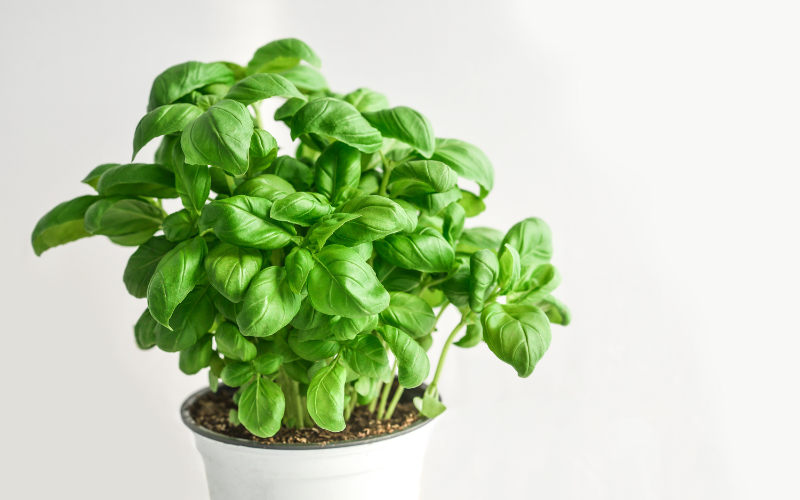
Basil is one of the most popular and versatile herbs for indoor gardening. It thrives in a sunny spot, requiring at least 6-8 hours of sunlight or supplemental light from grow lights. Basil adds fresh flavor to a wide variety of dishes, from pesto and salads to pasta sauces. Regular pruning will encourage bushy growth, making it one of the easiest herbs to grow indoors. For optimal results, keep the soil consistently moist but not waterlogged.
2. Mint
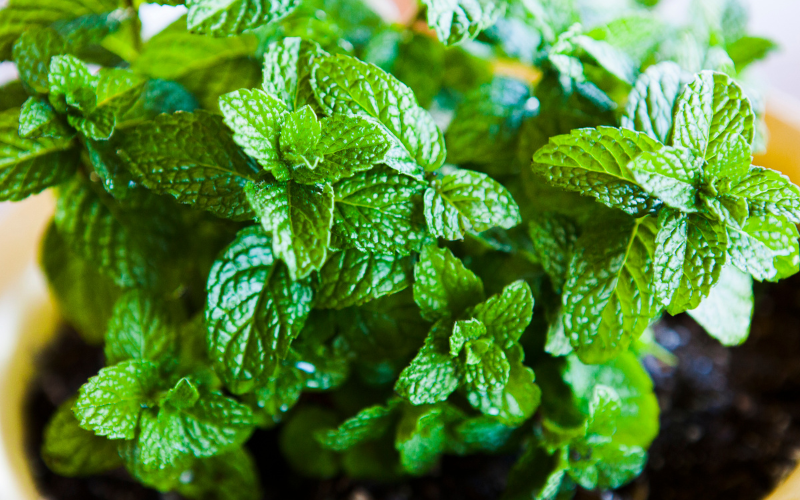
Mint is another ideal herb for indoor gardening, known for its rapid growth and versatility in the kitchen. Unlike other herbs, mint can tolerate lower light conditions, making it perfect for windowsills that don’t get direct sunlight. Mint is a great addition to teas, cocktails, and desserts, and its strong aroma helps repel pests indoors. Just be careful—mint can grow aggressively, so it’s best to plant it in its own container to avoid it overtaking other herbs.
3. Parsley
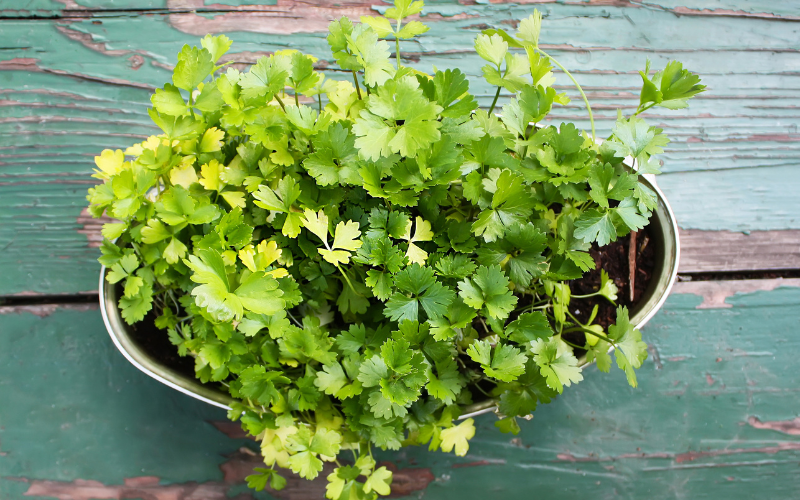
Parsley is a hardy herb that grows well indoors, particularly in indirect sunlight. It’s a great herb for garnishing dishes and adding to soups, salads, and sauces. Flat-leaf parsley (also known as Italian parsley) and curly parsley are both excellent choices for indoor gardening. Parsley prefers consistently moist soil and can tolerate lower light conditions compared to sun-loving herbs like basil. It’s also rich in vitamins, making it both a flavorful and healthy addition to your kitchen.
4. Cilantro
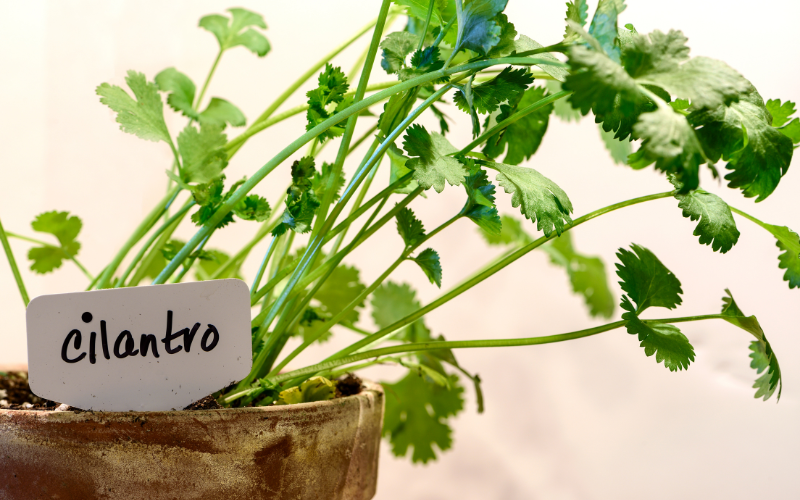
Cilantro (also known as coriander) is a fast-growing herb that thrives in cooler indoor environments. It prefers bright, indirect light and benefits from regular harvesting to prevent it from bolting (going to seed). Cilantro is commonly used in dishes like salsa, guacamole, and curries, making it a staple for any indoor herb garden. Keep the soil slightly moist and harvest frequently to enjoy fresh, fragrant cilantro all year long.
5. Thyme
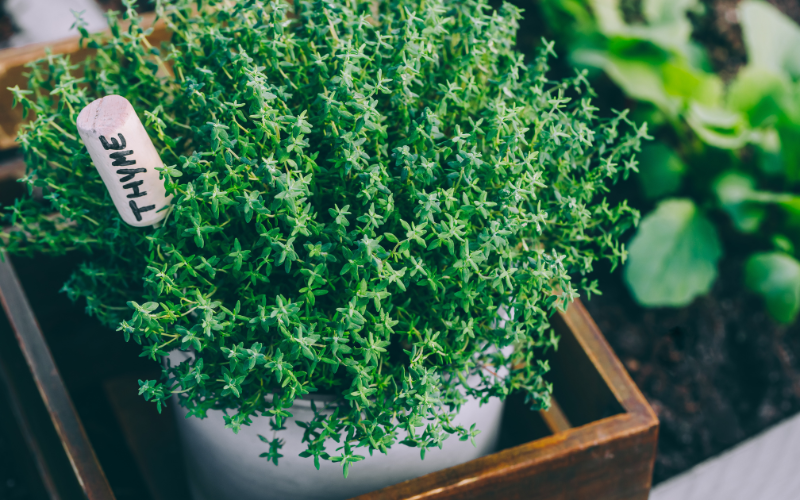
Thyme is one of the best herbs to grow indoors due to its drought tolerance and ability to thrive in both bright and moderate light conditions. It’s a low-maintenance herb that adds earthy flavor to meats, stews, and soups. When growing thyme indoors, use well-draining soil and allow the top inch of the soil to dry out between waterings. Thyme is a perennial herb, so with proper care, it will continue to grow for years, making it a great long-term addition to your herb garden.
6. Rosemary
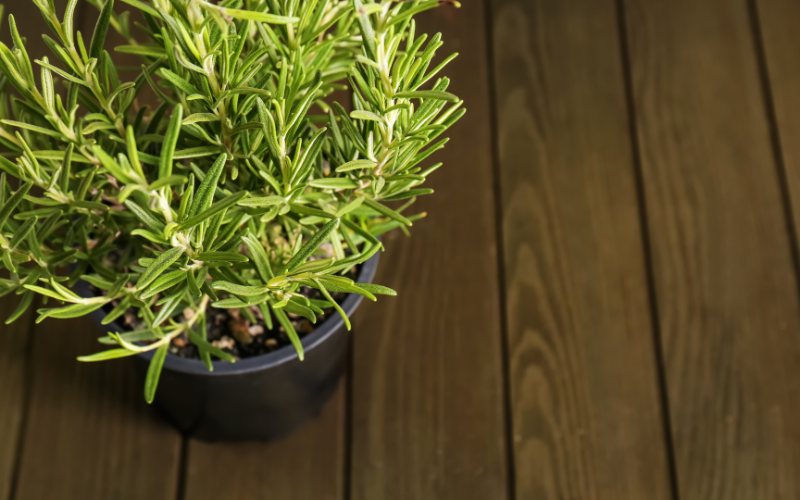
Rosemary is an aromatic herb that grows well indoors when placed in a sunny spot. It requires 6-8 hours of direct sunlight or bright artificial light. Rosemary adds depth to roasted meats, potatoes, and breads, and its woody stems also make it a beautiful ornamental herb. Be sure to water rosemary sparingly—it’s a drought-tolerant plant that prefers dry, well-draining soil. Overwatering is the most common mistake when growing rosemary indoors.
7. Chives
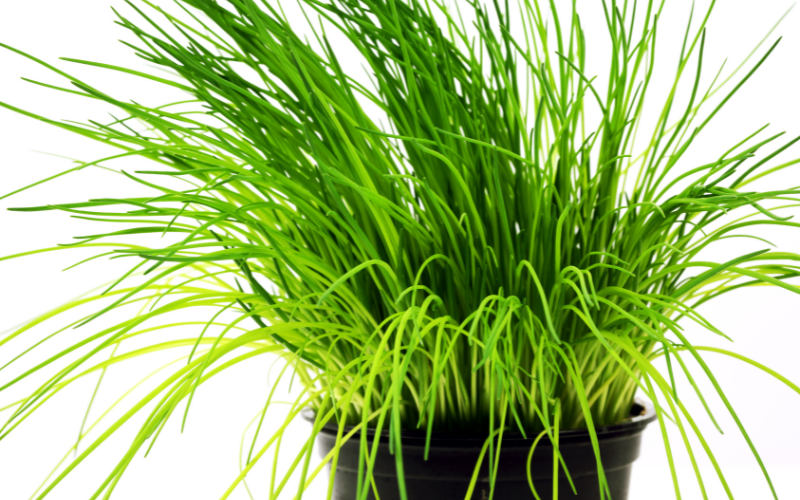
Chives are one of the easiest herbs to grow indoors, making them perfect for beginners. With their mild onion flavor, chives are a great addition to eggs, soups, salads, and baked potatoes. Chives thrive in bright, indirect light and can even tolerate lower light conditions, although they will grow faster in full sunlight. Snip the leaves regularly to encourage new growth, and enjoy fresh chives in your cooking all year long.
8. Oregano
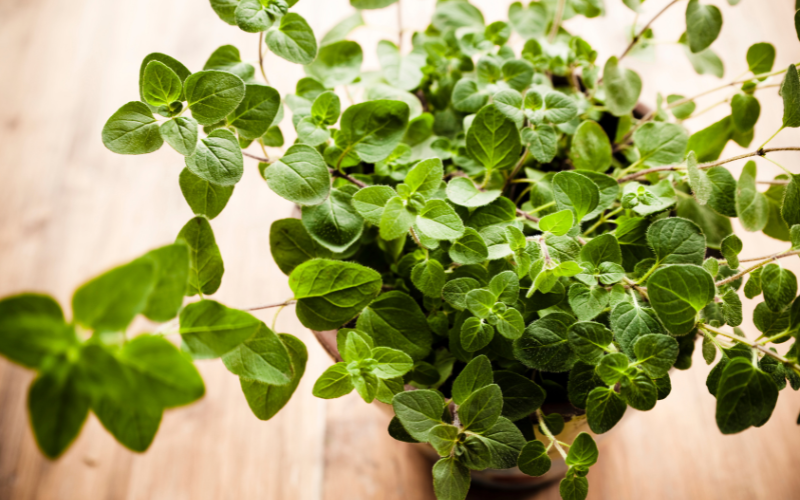
Oregano is a robust herb that thrives indoors, especially when provided with plenty of sunlight. It’s a must-have for Italian and Mediterranean dishes, including pizza, pasta, and marinades. Oregano prefers well-draining soil and should be watered only when the top layer of the soil feels dry. Regular pruning will keep oregano compact and prevent it from becoming leggy.
9. Sage
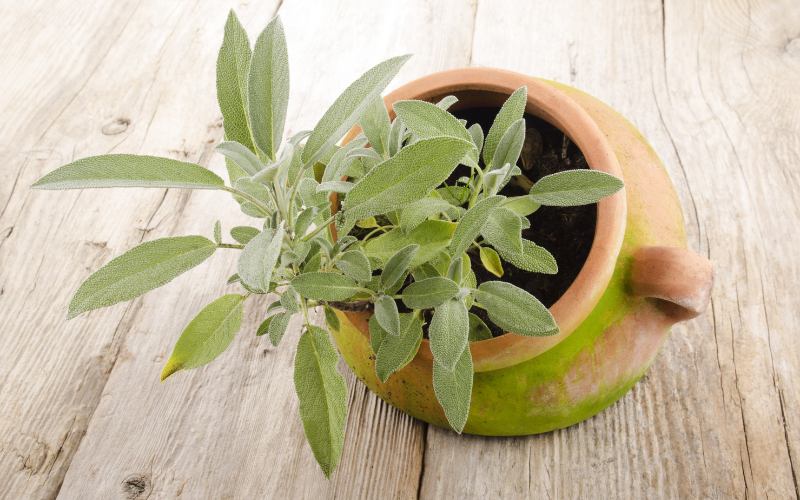
Sage is another herb that grows well indoors, especially in cooler indoor climates. It requires moderate sunlight and should be watered only when the soil feels dry. Sage is commonly used in savory dishes, such as stuffing, poultry, and roasted vegetables. It’s a hardy herb that can be grown year-round indoors with minimal effort, making it a great choice for beginners.
How to Maximize Herb Growth Indoors
To get the most out of your indoor herb garden, ensure your herbs receive the right amount of light, water, and nutrients. Use LED grow lights if natural sunlight is limited, and provide a well-draining, nutrient-rich organic potting mix for optimal root health (click here for more lighting requirements). Regular pruning and harvesting encourage bushier growth and help herbs maintain their flavor. By carefully choosing the right herbs and providing the proper care, you can enjoy fresh herbs indoors all year long. To make things easier for you check out these Hydroponics Growing Systems.
Setting Up Your Indoor Herb Garden
To create the ideal environment for growing herbs indoors, you need to ensure that you provide the right conditions for their growth. Here are the essentials for setting up your indoor herb garden:
1. Choosing the Right Containers
Herbs grown indoors need containers with good drainage to prevent waterlogging, which can cause root rot. Make sure your pots have drainage holes, or use containers with self-watering systems. Here are some popular container options:
- Terra cotta pots: These are breathable and help regulate moisture, but they can dry out faster than plastic pots.
- Plastic pots: Lightweight and less prone to drying out, but they don’t offer as much breathability.
- Hanging planters: If space is limited, vertical planters or hanging containers can make the most of small spaces.
2. Soil Selection
Herbs prefer well-draining soil that is rich in nutrients. Avoid using garden soil, which is often too heavy for indoor pots. Instead, use a high-quality potting mix specifically designed for indoor plants. A mixture that includes peat moss, vermiculite, or perlite will provide the right balance of drainage and moisture retention.
3. Lighting Requirements
Lighting is one of the most important factors for successfully growing herbs indoors. Most herbs need 6-8 hours of sunlight per day. If you don’t have a bright, sunny window, you can use grow lights to supplement natural light.
- LED grow lights are energy-efficient and provide the full spectrum of light that plants need to thrive.
- Fluorescent grow lights are also effective and less expensive than LEDs, making them a good option for small indoor herb gardens.
Position the lights 6-12 inches above your plants and keep them on for 12-16 hours a day to mimic natural sunlight.
4. Temperature and Humidity
Most herbs grow best in temperatures between 65°F and 75°F (18°C to 24°C). Keep your plants away from cold drafts, heating vents, or radiators, which can cause temperature fluctuations. In winter months, indoor air can become dry, so consider using a humidifier or misting your plants regularly to maintain adequate humidity levels.
5. Watering Herbs Indoors
One of the most common mistakes in indoor gardening is overwatering. Most herbs prefer their soil to dry out slightly between waterings. Basil and cilantro like consistently moist soil, while rosemary and thyme prefer drier conditions. Always check the top inch of soil before watering—if it’s dry, it’s time to water. Make sure excess water drains out of the bottom of the pot to prevent root rot.
How to Plant Herbs Indoors
Planting herbs indoors is an easy and rewarding process that can provide you with fresh ingredients all year long. To help you get started check out these indoor garden kits. Whether you’re starting from seeds or transplanting seedlings, creating the right environment and following best practices will ensure your herbs grow healthy and strong. Here’s everything you need to know to get started.
Starting Herbs from Seeds Indoors
Growing herbs from seeds is a cost-effective and gratifying way to begin your indoor herb garden. Here are the steps to successfully start herbs from seeds indoors:
- Choose the Right Seeds: Opt for fast-growing, easy-to-care-for herbs like basil, cilantro, or parsley. These are ideal for beginners and thrive in typical indoor conditions.
- Prepare the Containers: Use small pots, seed trays, or biodegradable containers with good drainage. Fill them with a high-quality, well-draining potting mix specifically formulated for indoor plants. Avoid using garden soil as it may not drain properly and could harbor pests or diseases.
- Plant the Seeds: Sow the seeds according to the recommended depth on the seed packet, typically about ¼ inch deep. Be careful not to overcrowd the seeds, as overcrowded herbs may struggle to thrive. Sowing seeds too close together can result in competition for light and nutrients.
- Water Properly: After planting, gently mist the soil with water. Keep the soil moist but not soggy during the germination process. Cover the containers with plastic wrap or a humidity dome to retain moisture, but remove it once the seeds start sprouting.
- Provide Ample Light: Place the containers in a bright, sunny location where they can receive at least 6-8 hours of sunlight per day. If natural light is limited, use grow lights to ensure your seeds receive enough light for healthy growth.
- Maintain the Right Temperature: Herbs prefer temperatures between 65°F and 75°F (18°C to 24°C). Keeping the seeds in a warm environment will help speed up germination.
- Transplant Seedlings: Once your herb seedlings have grown their first set of true leaves and are strong enough, you can transplant them into larger pots. Be gentle when transferring the seedlings to avoid damaging the delicate roots. Space the plants properly so they have room to grow.
Transplanting Herb Seedlings Indoors
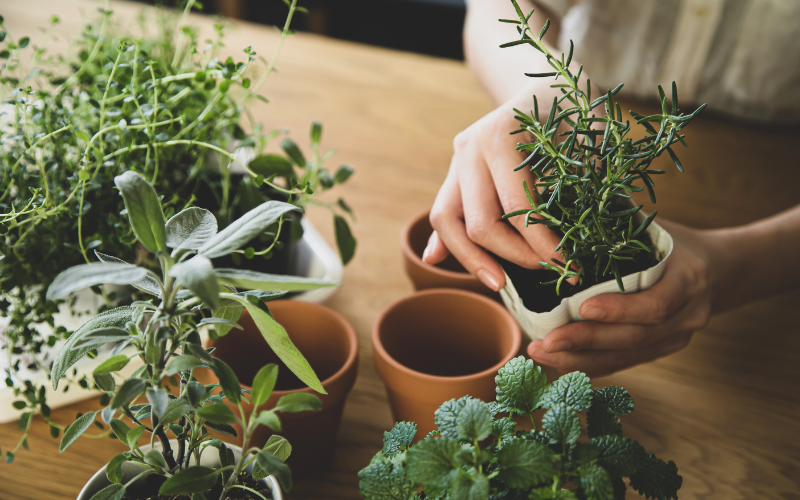
For a quicker start to your indoor herb garden, you can transplant herb seedlings that you’ve purchased or grown outdoors. Here’s how to transplant seedlings indoors:
- Select Healthy Seedlings: When purchasing seedlings from a garden center, choose healthy plants with green leaves and strong stems. Avoid any seedlings with yellowing leaves or signs of pests.
- Prepare the Pots: Choose containers with good drainage, ensuring they are large enough to accommodate the herb’s root system. A pot that is 6-12 inches in diameter is generally sufficient for most herbs. Fill the pot with a high-quality, nutrient-rich organic potting mix.
- Transplanting: Gently remove the herb seedling from its original container, being careful not to damage the roots. Create a hole in the new pot that’s large enough to fit the root ball, then cover it with soil. Press down lightly to eliminate air pockets and ensure the plant is stable.
- Water and Settle: After transplanting, water the herb thoroughly to help settle the soil around the roots. Make sure excess water drains out of the bottom of the pot.
- Light and Temperature: Place the transplanted seedlings in a location with plenty of light and keep them in a warm, stable environment to reduce transplant shock. Herbs like basil, oregano, and chives will quickly adapt to their new environment with the right care.
Choosing the Right Pots for Indoor Herbs
When planting herbs indoors, selecting the right container is critical to their growth and longevity. Consider the following when choosing pots for indoor herbs:
- Size: Most herbs need pots that are at least 6 inches in diameter to allow for root expansion. Larger containers, around 10-12 inches, are ideal for herbs with larger root systems, like rosemary.
- Material: Terra cotta pots are breathable, allowing excess moisture to escape, which is ideal for herbs that prefer drier conditions, like thyme or oregano. Plastic pots retain more moisture, which is beneficial for water-loving herbs like basil and mint.
- Drainage: Always use pots with drainage holes. Poor drainage can lead to waterlogged soil, which causes root rot. If your pot doesn’t have holes, consider adding a layer of pebbles at the bottom to improve drainage.
Indoor Herb Growing Kits
For beginners or those who want a convenient way to start an indoor herb garden, herb growing kits are a great option. These kits typically come with seeds, soil, and pots, making the process straightforward and easy to manage. They are also a great way to ensure you have the proper materials for growing herbs successfully indoors. For excellent Indoor Herb Growing Kits click here.
Watering Your Herbs After Planting
After planting or transplanting your herbs, proper watering is essential to ensure their growth. Most indoor herbs prefer to be watered when the top inch of soil feels dry to the touch. Be sure not to overwater, as this can lead to root rot. Herbs like rosemary and thyme prefer drier soil, while herbs like basil and parsley thrive in consistently moist (but not waterlogged) soil. Always use room-temperature water to avoid shocking the plants.
By following these best practices for planting herbs indoors, you’ll set the foundation for a thriving indoor herb garden that provides fresh, flavorful herbs all year long.
Fertilizing Your Indoor Herbs
Proper fertilization is essential for keeping your indoor herbs healthy and productive, as they rely on limited soil nutrients in containers. Since herbs grown indoors don’t benefit from the natural nutrient cycling found in outdoor environments, it’s important to provide them with supplemental nutrients.
How Often to Fertilize Indoor Herbs
To maintain vigorous growth, feed your herbs with a balanced, water-soluble fertilizer every 4-6 weeks. Over-fertilizing can cause excessive leaf growth with less flavor, so it’s essential to avoid using too much. For herbs like basil, parsley, and cilantro that are harvested regularly, a light feeding schedule will encourage consistent regrowth. Herbs such as rosemary and thyme, which grow more slowly, require less frequent feeding.
Choosing the Best Fertilizer for Indoor Herbs
Look for fertilizers that are designed for herbs or vegetables. Organic options, like compost tea, fish emulsion, or worm castings, are ideal for growing edible plants as they provide nutrients without harmful chemicals. These natural fertilizers improve the health of your herbs while maintaining their robust flavor, which is crucial when using them in cooking. You can also use slow-release fertilizers if you prefer a less frequent fertilizing schedule.
Signs Your Herbs Need Fertilizer
It’s important to monitor your herbs for signs of nutrient deficiencies. Yellowing leaves, stunted growth, or weak stems may indicate that your plants need extra nutrients. Conversely, if your herbs have lush foliage but little flavor, you may be over-fertilizing. In that case, cut back on the frequency and quantity of fertilizer to strike the right balance between growth and flavor.
By following these tips, you’ll ensure your indoor herbs receive the right nutrients to thrive, providing fresh, flavorful ingredients for your kitchen.
Pruning and Harvesting Your Indoor Herbs
Pruning and harvesting are essential steps in maintaining a thriving indoor herb garden. Regular pruning not only promotes bushier growth but also helps keep your herbs healthy by preventing legginess and encouraging new shoots. Knowing how and when to harvest your herbs is key to maximizing their flavor and ensuring they continue to produce fresh leaves.

How to Prune Indoor Herbs for Maximum Growth
Pruning helps stimulate new growth by redirecting the plant’s energy toward producing more leaves. The best practice is to prune your herbs frequently, especially fast-growing varieties like basil and mint. When pruning, use clean, sharp scissors or pruning shears to snip stems just above a leaf node, which is the point where new growth emerges. This encourages the plant to grow outward rather than becoming tall and spindly.
For herbs like rosemary and thyme, which grow more slowly, less frequent pruning is needed. However, removing the top inch of growth every few weeks will help these plants stay compact and healthy. Pruning herbs before they flower also enhances flavor, as flowering can lead to bitter leaves.
Best Time to Harvest Indoor Herbs
Harvesting herbs at the right time is essential for achieving the best flavor. For most herbs, the ideal time to harvest is in the morning, after the dew has dried but before the heat of the day, when the essential oils in the leaves are at their peak. Regularly harvesting your herbs helps encourage continuous growth. For optimal flavor:
- Basil and mint should be harvested frequently by pinching off the top leaves.
- Chives, parsley, and cilantro can be cut close to the base, and they will regrow from the root.
- For woody herbs like rosemary and thyme, snip off the newer, tender growth rather than older stems.
How Much to Harvest Without Damaging the Plant
It’s important to harvest herbs in moderation to avoid stressing the plant. A good rule of thumb is to never remove more than one-third of the plant’s leaves at a time. This allows the herb to continue photosynthesizing and growing strong. For herbs like basil, which grow quickly, you can harvest more frequently, while slower-growing herbs like oregano or sage should be harvested more sparingly.
By mastering the art of pruning and harvesting, you will keep your indoor herbs healthy, flavorful, and productive, providing a continuous supply of fresh herbs for cooking all year long.
Common Issues in Indoor Herb Gardening and How to Fix Them
Even with the best care, indoor herb gardens can sometimes encounter problems. Recognizing these common issues and knowing how to resolve them will help keep your herbs healthy and productive. Here are some of the most frequently encountered problems with indoor herb gardening, along with solutions to fix them.
1. Yellowing Leaves
Yellow leaves are often a sign that your herbs are stressed, which can be caused by a variety of factors, including overwatering, underwatering, or nutrient deficiencies. If your herbs’ leaves are turning yellow:
- Overwatering: Herbs need well-draining soil. Waterlogged roots can lead to yellowing and root rot. Always check the soil’s moisture before watering and ensure that your pots have proper drainage.
- Underwatering: If the soil is too dry, herbs may also start to yellow. Be sure to water your herbs when the top inch of the soil is dry.
- Nutrient Deficiency: If your herbs are lacking essential nutrients, especially nitrogen, they may develop yellow leaves. Use a balanced, water-soluble fertilizer to restore nutrients.
2. Leggy Growth
Leggy growth occurs when your herbs are reaching for light and don’t have enough energy to produce strong, bushy growth. This is especially common with herbs like basil and thyme if they aren’t receiving enough sunlight. To fix this issue:
- Increase Light Exposure: Move your herbs to a sunny window where they can get 6-8 hours of sunlight per day. If that’s not possible, invest in LED grow lights to supplement the natural light.
- Rotate Plants: Turn your pots regularly so all sides of the plant get equal exposure to light, helping them grow evenly.
- Prune Regularly: Pruning encourages bushier growth and prevents herbs from becoming leggy. Snip off the top growth to promote new, fuller shoots.
3. Pests on Indoor Herbs
Even indoors, herbs can fall victim to pests like aphids, spider mites, and fungus gnats. These pests can weaken your plants by sucking out their nutrients. Here’s how to handle common pest problems:
- Aphids: These small, sap-sucking insects can be treated by wiping the leaves with a solution of water and a mild insecticidal soap. For a natural remedy, try spraying the plant with a mixture of water and neem oil.
- Spider Mites: These pests thrive in dry conditions. Increase the humidity around your plants by misting them regularly, and treat infestations with neem oil or insecticidal soap.
- Fungus Gnats: Overwatering can lead to fungus gnat infestations. Allow the soil to dry out between waterings and consider placing sticky traps near the plants to catch the adult gnats.
4. Mold and Mildew
High humidity or poor air circulation can lead to the development of mold or mildew on the soil surface or plant leaves. To prevent and treat mold:
- Improve Air Circulation: Ensure good airflow around your herbs by spacing them out and, if necessary, using a small fan.
- Water from the Base: To prevent mold on the surface, water your plants from the base or use self-watering pots to keep the foliage dry.
- Use Cinnamon: A natural antifungal, cinnamon can be sprinkled on the surface of the soil to help combat mold growth.
5. Slow or Stunted Growth
If your herbs are not growing as vigorously as expected, they may be lacking sufficient light, nutrients, or space for their roots to expand. To address slow or stunted growth:
- Check for Root Bound Plants: If the roots have outgrown their container, repot the herb in a larger pot to give the roots more room.
- Ensure Proper Fertilization: Indoor herbs may require more frequent fertilization than outdoor plants. Use an organic fertilizer every 4-6 weeks to provide essential nutrients.
- Optimize Lighting: Make sure your herbs are receiving enough light. If natural light is insufficient, consider using a grow light to boost growth.
By identifying and addressing these common issues early, you can maintain a healthy, productive indoor herb garden. Whether you’re dealing with yellow leaves, pests, or slow growth, the right solutions will help your herbs thrive.
Creative Ideas to Maximize Your Indoor Herb Garden
If you’re looking to take your indoor herb garden to the next level, consider these creative ideas:
1. Vertical Herb Garden
A vertical herb garden is a great way to save space and make your indoor herb garden aesthetically pleasing. You can use hanging planters, wall-mounted containers, or tiered shelves to grow multiple herbs in a small space. Ensure all your herbs still get adequate light, either by positioning them near a sunny window or using grow lights.
2. Windowsill Herb Garden
A windowsill herb garden is one of the easiest ways to grow herbs indoors. Herbs like basil, chives, parsley, and thyme thrive on a sunny windowsill. Use uniform pots or a long planter box to keep things organized and visually appealing. Ensure your window receives at least 6 hours of sunlight per day for optimal growth.
3. Herb Terrariums
Create a mini indoor garden using glass containers or jars for a decorative herb terrarium. Choose herbs that thrive in high-humidity environments, such as mint or basil, and ensure the container has proper drainage or moisture control. Terrariums can double as both functional and decorative pieces in your home.
4. Hydroponic Herb Garden
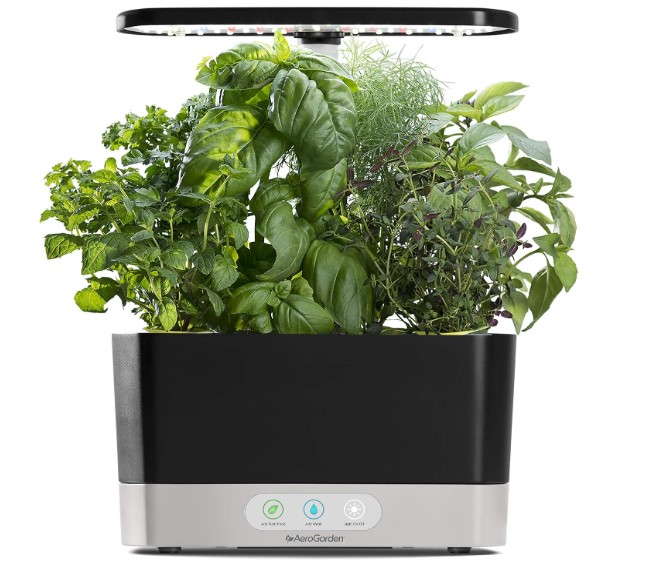
If you’re serious about growing herbs indoors, consider a hydroponic system. Hydroponics allows you to grow herbs without soil, using nutrient-rich water. Hydroponic systems come in many sizes, from small countertop setups to larger units that can accommodate multiple plants. This method ensures faster growth and uses less water compared to traditional soil gardening.
5. Kitchen Herb Wall
Install small shelves or hang pots on a kitchen wall to create a dedicated space for your indoor herb garden. This makes it easy to snip fresh herbs while cooking, and the greenery adds a natural touch to your kitchen decor. Just ensure that your herb wall is in a spot that receives plenty of natural light.
Best Practices for Long-Term Care of Indoor Herbs
To keep your herbs thriving in the long term, follow these best practices:
1. Rotate Your Plants
Even with the best grow lights or window placement, herbs can sometimes grow unevenly if one side is consistently exposed to more light. Rotate your pots every few days to ensure all sides of your plant receive an equal amount of sunlight.
2. Use Organic Pest Control
When growing edible plants indoors, it’s essential to avoid harsh chemicals. Opt for natural pest control methods, such as neem oil or insecticidal soap, to treat pest infestations. You can also use natural deterrents like crushed eggshells or diatomaceous earth around the base of your plants to keep pests away.
3. Repot Herbs as Needed
As your herbs grow, they may outgrow their containers. If you notice roots growing out of the drainage holes or your plant seems to be struggling, it may be time to repot it. Choose a container that’s 1-2 inches larger in diameter and refresh the soil with a nutrient-rich potting mix.
4. Monitor Humidity Levels
Indoor environments, especially during winter, can become quite dry, which may not be ideal for herbs that prefer more humid conditions. Using a humidifier or regularly misting your herbs can help maintain the right humidity levels. Alternatively, placing your plants on trays filled with pebbles and water can also help increase local humidity.
5. Fertilize Sparingly
While herbs benefit from the occasional feeding, over-fertilizing can reduce their flavor and cause excessive leaf growth. Stick to a light, balanced fertilizer every 4-6 weeks and consider using organic options, like compost tea or diluted fish emulsion.
Frequently Asked Questions (FAQs) About How to Grow Herbs Indoors
1. Can I grow herbs indoors without sunlight?
Yes, you can grow herbs indoors without natural sunlight by using grow lights. LED and fluorescent grow lights are excellent for providing the necessary spectrum of light for herbs to thrive. Position your grow lights 6-12 inches above your plants and leave them on for 12-16 hours a day to mimic sunlight.
2. How long do indoor herbs last?
With proper care, many herbs can last for months or even years indoors. Perennials like thyme, rosemary, and mint can continue growing year after year, while annuals like basil may need to be replanted after a few months or at the end of their growing season.
3. Why are my herbs turning yellow?
Yellowing leaves are often a sign of overwatering, poor drainage, or nutrient deficiencies. Check the soil’s moisture levels and ensure your pots have proper drainage. If the problem persists, consider fertilizing your herbs with a balanced, water-soluble fertilizer.
4. What are the easiest herbs to grow indoors?
Some of the easiest herbs to grow indoors include basil, mint, chives, and thyme. These herbs require minimal care and thrive in typical indoor environments with enough light and water.
5. Can I grow multiple herbs in one pot?
Yes, you can grow multiple herbs in one pot if they have similar water and light requirements. For example, parsley and cilantro can be grown together, as they both prefer moist soil and bright, indirect light. Avoid planting herbs with vastly different needs, like drought-tolerant rosemary with moisture-loving basil, in the same pot.
Start Growing Your Indoor Herb Garden Today!
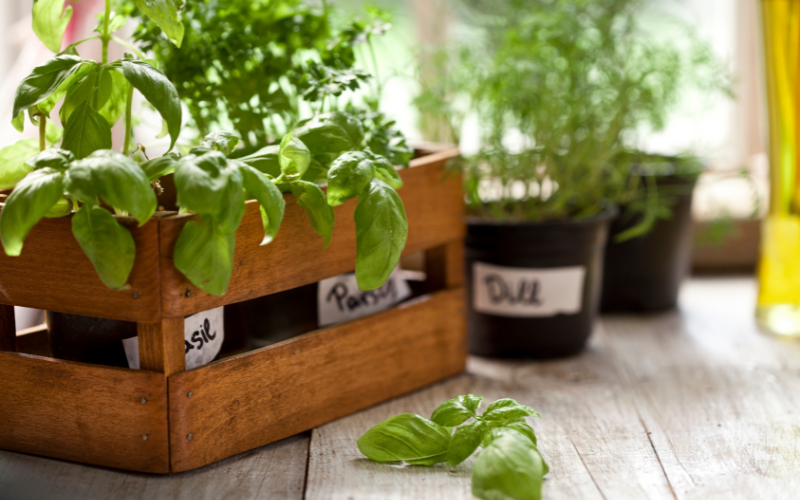
Growing herbs indoors is an easy, rewarding, and sustainable way to have fresh ingredients at your fingertips year-round. Whether you’re a seasoned gardener or a beginner, following this guide will help you create a thriving indoor herb garden. From choosing the right herbs to setting up the ideal growing environment, you now have all the tools needed for success.
By optimizing your setup and providing consistent care, your indoor herbs will flourish, adding freshness to your meals and beauty to your home. Don’t wait—start your indoor herb garden today and enjoy the endless culinary possibilities that come with growing your own herbs!

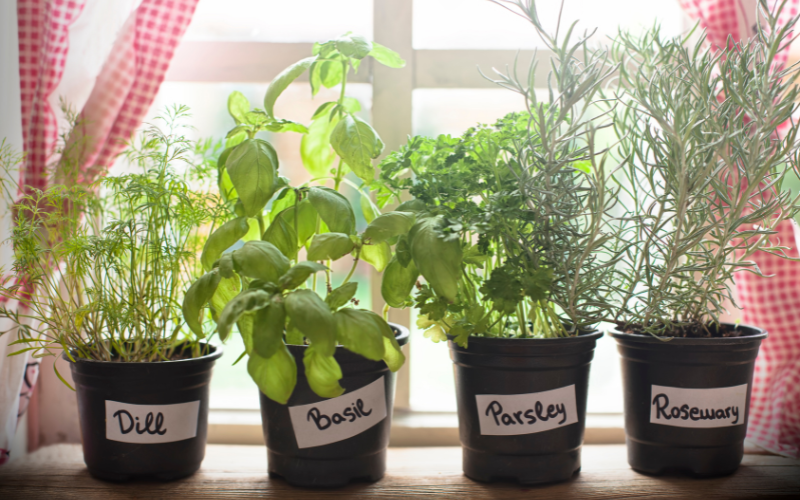
1 thought on “How to Grow Herbs Indoors: The Ultimate Guide for Year-Round Freshness”
Comments are closed.